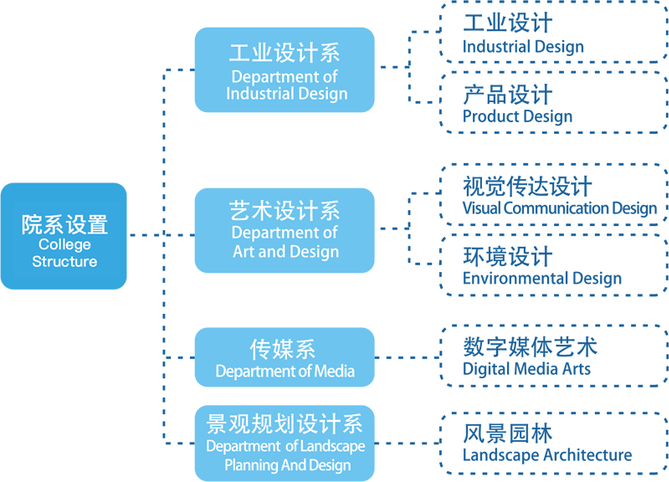
The School comprises four departments: the Department of Industrial Design, the Department of Landscape Planning and Design, the Department of Art and Design, and the Department of Media.
I.Department of Industrial Design
rograms: Industrial Design& Product Design
1.Industrial Design
Industrial Design is a forward-looking interdisciplinary field that integrates creative design with scientific and technological innovation. The program emphasizes synergy with mechanical engineering, information science, materials science, and energy engineering, while focusing on the interrelationships among product structure, function, material, and form. Rooted in the harmonious integration of people, products, and the environment, and guided by a human-centered approach to technology, the program is committed to cultivating innovative professionals with a solid theoretical foundation, advanced practical skills, and strong creative and research capabilities. With distinct advantages in market-driven collaboration and design innovation, and recognized expertise in ergonomics, Kansei Engineering, and design methodology, the program was designated in 2022 as a National First-Class Undergraduate Program.
2.Product Design
Building upon the foundations of Industrial Design while maintaining its distinctive focus, the Product Design program equips students with a systematic mastery of theoretical knowledge and practical skills in the field. The curriculum integrates technological advancement, artistic principles, industry dynamics, cultural heritage, and sustainability, all within a human-centered design philosophy. The program emphasizes comprehensive abilities in product development, refinement, and innovative integration, drawing on knowledge from science, technology, economics, culture, and aesthetics. Graduates develop both artistic sensibility and scientific literacy, enabling them to pursue careers in product design, research, teaching, and management, as well as in related areas such as packaging, exhibition, branding, and market development.
II.Department of Landscape Planning and Design
Program: Landscape Architecture
1.Landscape Architecture Program
Landscape Architecture is a discipline that integrates science and art to create inspiring and sustainable outdoor environments. Grounded in biological and ecological sciences, it also draws on related fields such as civil engineering, architecture, urban planning, philosophy, history, literature, and the arts.
The program is committed to cultivating well-rounded professionals with integrity, broad knowledge, practical competence, and innovative vision. Students receive comprehensive training in landscape and urban planning and design, as well as the design of scenic areas and green spaces, preparing them for careers in planning, design, construction, and management across urban and landscape sectors.
Distinguished by its emphasis on regional cultural heritage, garden architecture, ecological technologies, and diverse landscape practices, the program equips graduates to contribute meaningfully to cultural heritage preservation, landscape planning and design, garden architecture, and sustainable development.
III.Department of Art and Design
Programs: Visual Communication Design& Environmental Design
1.Visual Communication Design Program
Visual Communication Design leverages the power of visual language to convey ideas, information, and creativity. In response to the rapid growth of cultural and creative industries, the program provides broad opportunities for innovation and development. Drawing on Shanghai’s position as a global metropolis, it places strong emphasis on practical training and curriculum innovation, fostering creativity, interdisciplinary integration, and independent thinking.
The curriculum covers a wide range of areas, including brand visual design, AI-driven visual design, motion design, interactive design, spatial visual design, and integrated design, ensuring alignment with international trends and the evolving demands of the creative industries. Distinctive in character and future-oriented in vision, the program equips students with the skills and mindset to thrive in an increasingly dynamic design landscape.
2. Environmental Design Program
Also known as Environmental Art Design, Environmental Design is an emerging program that integrates architecture, interior design, public art, and landscape design. Rooted in architectural studies, it focuses on shaping artistic environments for both interior and exterior spaces. Compared with architecture, it places greater emphasis on the aesthetic atmosphere of space; compared with urban planning, it highlights attention to detail; and compared with landscape design, it underscores the harmony between individual elements and the whole.
As an organic integration of culture, art, and technology, the program provides comprehensive training through courses such as architectural fundamentals, interior design, environmental planning, computer-aided design, and model-making. Graduates are well prepared for careers in environmental and architectural design, renovation, exhibition design, as well as research and teaching.
IV.Department of Media
Program: Digital Media Art
1.Digital Media Art Program
This program addresses the opportunities and challenges of the digital and intelligent era by drawing on the University’s strengths in engineering and the School’s expertise in creative design and communication. Building on more than a decade of experience with the Advertising program, it emphasizes the creative visualization of science communication, public service, and regional culture, alongside integrated media communication. Through interdisciplinary collaboration, the program has developed an innovative educational model that integrates industry with education and fosters synergy between science and art.
Anchored in design, computer science, and communication, and enriched by perspectives from theatre and film, the program focuses on two primary directions: digital media brand strategy and digital imaging and applications. Its curriculum provides systematic training across four dimensions—media creativity, content development, expression, and dissemination—cultivating students’ capacity for end-to-end design innovation and applied engineering practice. Graduates are prepared to excel in the rapidly evolving media landscape.


